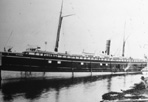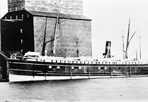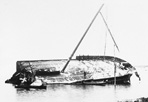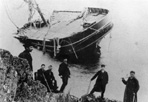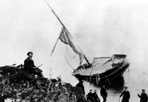Panoramic001.jpg)
SS Algoma
Quick Facts
1813
Aiken & Mansell
270 feet
1,773 tons
Canadian Pacific Railway
John Moore
Iron and Brass
Canadian Pacific Railway
Canadian Pacific Railway
Unknown
U.S. 85766
11/05/1885
$300,000
Southeast shore of Mott Island
Minimum 10 feet; maximum 100 feet
45
84001699
A
LGOMA was one of the first steel-hulled vessels on the Great Lakes (Scanner 1976:6 from The British Whig Oct. 18,1883). Like many of the early iron and steel vessels of the Lakes, it was built in British shipyards. Britain led the world in the development of iron and steel shipbuilding, and Great Lakes owners were frequent customers. Fleet orders from the Lakes were not uncommon, particularly from Canada, for vessels constructed on the Clyde. Kelvinhaugh was a leading producer of iron and steel vessels, and some Scottish companies (particularly in the 1920s) specialized in the manufacture of Lakers (Walker 1984:58; Carvel 1950:46).

SS Algoma, Mott Island, 1883: Historic Photograph Collection, ISRO Archives.
The one problem faced by the foreign shipbuilders and Great Lakes owners was that the vessels had to pass through the canal system from the ocean to the Lakes. A vessel that was built small enough to pass was too small to benefit from the economies of scale enjoyed by larger vessels constructed on the Lakes. The solution was to design vessels to pass through the St. Lawrence Canals in pieces, to be reassembled once in the Lakes. This was accomplished in two ways: by either producing the vessels in sections and transporting to the Lakes on other ships (Carvel 1950:46), or designing the vessels to sail under their own power to the Lakes and then be severed in two and bulkheaded for the passage through the canals.
ALGOMA was built by Aitken and Mansel of Glasgow, Scotland for Canadian Pacific Railway (CPR). The ship, with its two sisters ALBERTA and ATHABASCA (the earliest spelling was ATHABASKA), were the first steamers to be purchased by the new line and were used in the Owen Sound-Port Arthur run that connected the railway across Lake Huron and Lake Superior. The three vessels were similarly built, with steel hulls of 263.5 feet in length, 38.2 feet in beam and 23.3 feet in depth (Scanner 1974:8), giving a gross tonnage of about 1750 as originally built. The completed vessels would be able to accommodate about 240 first-class passengers and 600 steerage passengers.
Operational History
Thunder Bay Sentinel May 16, 1884:
The appearance of the vessel as she neared the dock was striking. Every available piece of bunting was spread to the wind, and she rode in as stately as any ocean steamer ever entered harbor. The scene which presented itself upon the main deck can only be likened to the appearance of an ocean emigrant ship upon her arrival at an American seaport. Over a thousand steerage passengers were crowding round the gangways ready to land as soon as an opportunity offered. Of the general excellence of the boat herself too much cannot be said in her favor. She is certainly the finest boat that has ever sailed upon these great inland seas, and her superiority over all other Lake craft in every particular is at once apparent. She has a crew of 35 all told, Captain Moore commands her, and her first and second mates are M.S. Hastings and R. McLeod, respectively. George Pettigrew is the chief engineer and his assistant is A. McDermid. R. McKenzie is purser, and G. Taylor is steward (Thunder Bay Sentinel May 16, 1884). See also Owen Sound Advertiser Nov. 12, 1885).
ALGOMA, completed in March (Thunder Bay Sentinel March 14, 1884), was ready to begin operations in May, 1884. The ports of call on the first voyage were to be Cleveland, Detroit, Windsor, and Sarnia, with a public gathering planned for the arrival at Owen Sound. Before its departure from Port Colborne, some concern was expressed that the new CPR ships had such a deep draft that, even when light, they would be able to enter few of the Lake harbors (Cleveland Herald May 2, 1884). The ships drew a little over 7 feet when light and could carry 1,000 tons on 12 feet of draft (Cleveland Herald May 24, 1884).
On May 16, ALGOMA was the first of the new steamers to arrive at the Lakehead port. The ship had left Owen Sound at 3 am on Sunday and arrived at the Sault River that evening and made Sault Ste. Marie by 9:30 p.m. Along the way ice was encountered. An indication of the speed capability of the new ship was demonstrated when ALGOMA overtook the steamer NYACK, quickly passing it and in a run of 17 miles, gained four miles on the older vessel. ALGOMA had 250 tons of pig iron aboard and 16 carloads of baggage (Thunder Bay Sentinel May 16, 1884). Eight hundred to 1,000 people were waiting on the wharves when ALGOMA pulled into the Marks' Dock at 8:30 a.m.
Wreck Event
As the 1885 season drew to a close, it was clear it would be a poor one for Lake transportation. Severe competition, low rates, and smallpox were listed as the principal causes of the worst season on the Lakes in years. Several lines of steamers were laid up during the season. The only company to report a decided improvement was the Canadian Pacific Company, owners of the three new steel sisters ATHABASCA, ALBERTA and ALGOMA (Cleveland Leader Oct. 18, 1885). The season was not over for the successful company, however. Before the 1885 season closed, CPR would suffer the worst human life disaster in Lake Superior history.
ALGOMA left Owen Sound for Port Arthur Thursday, Oct. 5, 1885, loaded with cargo and the fewest passengers it had ever carried. There were seven cabin and six steerage passengers (or five cabin and 6 steerage, Owen Sound Times Nov. 12) aboard; the cargo consisted of 134 tons of general merchandise, and 297 tons of railway supplies (Duluth Tribune (Weekly) Nov. 13; New York Times Nov. 11, 1885). The light passenger list could be attributed to the lateness of the season and to the general decline of passenger traffic as a result of the opening of the "all rail" route around Lake Superior (Owen Sound Advertiser Nov. 12, 1885) earlier in 1885.
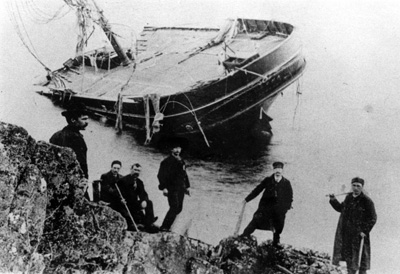
SS Algoma, Mott Island, 1885: Historic Photograph Collection, ISRO Archives.
According to Capt. Moore, ALGOMA passed through the Sault Ste. Marie canal on Friday Nov. 6, about noon. The steel steamer ran into a heavy gale and blinding snow storm at the halfway point of crossing Lake Superior. The storm increased in intensity until it quickly reached hurricane proportions. The storm of Friday night and Saturday morning was "beyond a doubt one of the greatest hurricanes that have occurred during the last 5 years. The dreadful storms of 1881-2-3, which did so much damage, were exceeded in violence by the terrible tempest of the 6th and 7th, in the opinion of many old seamen" (Port Arthur Sentinel Nov. 13, 1885).
The storm racked ship was rolling so severely that the first mate ordered the sails set to steady it. Under sail and steam combined, ALGOMA made 15 miles an hour or better, but was drifting to leeward off the set course. A lookout was posted about 3 a.m. to sight the Passage Island light. The steamer maintained its speed until about 4 a.m. when the captain ordered the sails down and a change of course. The engines were stopped while the sails were lowered and the new course set. At 4:40 a.m., less than five minutes after the engine telegraph bells sounded to go ahead, there was a crash (Port Arthur Herald Nov. 14, 1885). ALGOMA was aground on Isle Royale.
Media Coverage / Survivor Accounts
Port Arthur Herald, Tug Hattie Vinton, 11/14/1885
Port Arthur Herald: 11/14/1885
Watertown Times: 11/17/1885
Owen Sound Times: Moore, 11/19/1885
Owen Sound Times: McCarter, 11/19/1885
Owen Sound Adviser: Hastings, 11/19/1885
Owen Sound Adviser: McLean, 11/19/1885
Letter to Miss MacKenzie, from First Officer Hastings
Meaford Monitor: 11/20/1885
Image Gallery
Shipwreck Site Map
The vessel was salvaged; the engines and boiler were refitted in the vessel Manitoba. Parts of the stern are all that remain. Wreckage is widely scattered with no major sections intact. Bow section not yet located. This remains the largest loss of life on Lake Superior. Buoy on a sinker in 50 feet.
Citations:
- Isle Royale Shipwrecks. December 15, 1965. Isle Royale National Park Archives, Resource Management Records: Branch Chief Era, CRM History (ACC#ISRO-00614, Box 117), Houghton, MI.
- Lenihan, Daniel. Submerged Cultural Resources Study. Santa Fe, N.M: Submerged Cultural Resources Unit, National Park Service, 1987. Print.


